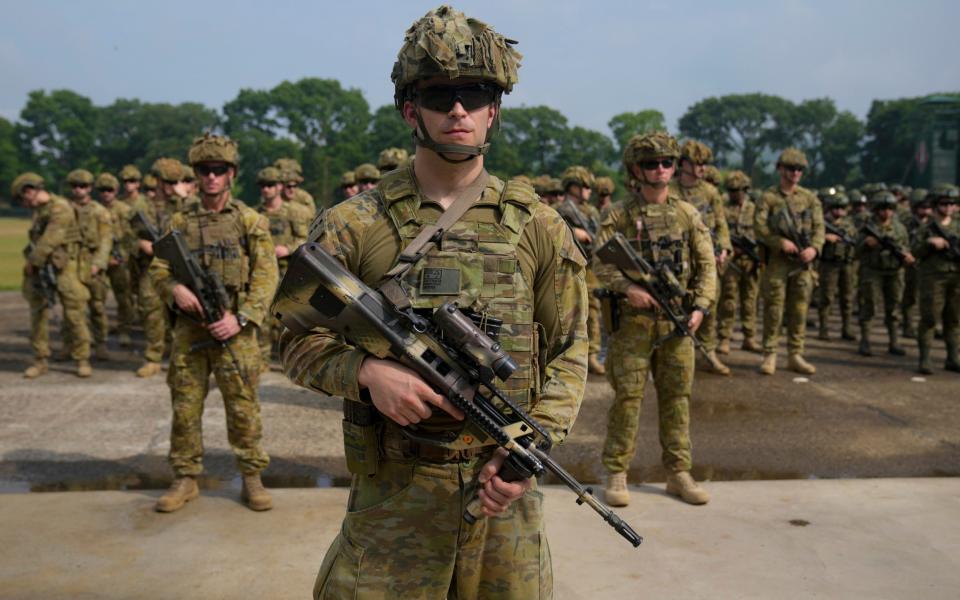Australia prepares for biggest defence shake-up since Second World War

Under the glittering chandeliers of the hotel ballroom, the Australian prime minister’s warning was clear: a breakdown in communications between the United States and China could be disastrous.
Speaking to the world’s defence chiefs in Singapore at the Shangri-La summit this weekend, Anthony Albanese warned the consequences of “such a breakdown – whether in the Taiwan Strait or elsewhere – would not be confined to the big powers or the site of their conflict; they would be devastating for the world”.
Mr Albanese was given top billing at the summit, evidence that his country has emerged as a major player in a region facing numerous potential conflict flashpoints.
For decades, Australia felt reassured that its geographical remoteness and the limited ability of neighbours to project power offered a 10-year window to prepare for any conflict.
But the rise of a muscular China under President Xi Jinping and advances in long-range missile technology have destroyed those assumptions. Coupled with North Korea’s nuclear ambitions, a “loss of warning time” is driving Australia’s fundamental rethink of how to prioritise billions in defence spending to best protect itself and be ready to assist allies if called upon.
Australia wants to be a “force for dialogue”, Mr Albanese said before sitting down for a meal of scallops and chicken ballotine in the somewhat awkward seat between Lloyd Austin, the US secretary of defence, and General Li Shangfu, his Chinese counterpart.
Moments earlier, the two defence chiefs had shared a handshake and a polite smile, but a US invitation to “more substantive talks” was declined by the Chinese – an unwillingness Mr Austin said left him “deeply concerned”. Against the backdrop of tense relations between Beijing and Washington, Australia has launched the most significant overhaul of its military since the Second World War to deter an increasingly assertive China.
The Defence Security Review, an overhaul of military preparedness to counter new threats, followed the £194 billion AUKUS deal with the US and UK to build and acquire up to eight nuclear-powered submarines – described by Mr Albanese as “the single biggest leap in Australia’s defence capability in our history”.
The review shifts Canberra’s emphasis on national security towards long-range strike capabilities and building weapons at home. It stresses accelerated acquisition of long-range strike missiles and manufacturing munitions domestically, while pushing ahead with upgrades for F-35A Joint Strike Fighter and Super Hornet aircraft to operate a suite of maritime strike weapons.
The 2023-24 defence budget, which exceeded A$50 billion (£26.3 billion) for the first time, allocates A$12.3 billion on new equipment, including A$1.2 billion for US precision-guided munitions.
Australia aims to fast-track the acquisition of 20 of the Himars rocket artillery systems that have proven so effective in Ukraine, to increase the military’s strike range up to 300km.
But the shuffling priorities have triggered debate over whether costly off-the-shelf foreign purchases are trumping indigenous production, and whether the Australian Defence Force, already struggling to recruit, is being underfunded. Experts question whether the security review goals can be met without a more significant budget increase.
However, AUKUS, a core priority in Canberra’s plan to defend Australia further from its shores, is forging ahead. The plan to build submarines based on a British-led design has reset defence ties between the UK and Australia, said Euan Graham, a senior fellow for Asia-Pacific security at the International Institute for Strategic Studies think-tank.
The UK’s leading role had elevated it again to “a primary European partner for the Australians” and dispelled the notion it was a “handmaiden” to America, added Mr Graham.
The planned forward deployment of a UK Astute-class submarine on a rotation with four US Virginia-class submarines to western Australia from 2027 was a “gamechanger” and “genuine strategic change”, he said, adding: “The UK has delivered.”
He added: “The defence strategic review says Australia must engage with the UK at a closer level in the Indo-Pacific. That word ‘must’ is there and quite significant. It is not a ‘nice to have’, it’s seen now as an important partnership in its own right.”
Australia has been forced to take a “360 degree” view of possible crises in its own backyard, said Bec Shrimpton, director of defence strategy and national security at the Australian Strategic Policy Institute.
“Taiwan is the nightmare scenario that everybody knows is out there,” she said of the risk that China may try to occupy the democratic island of Taiwan, drawing the world into war.
But the danger of conflict could rise from multiple horizons, she warned – particularly from miscalculations or accidents in a more heated environment where Beijing is assertively pushing its sovereignty claims and military activity on all sides is spiking.
China is also increasingly asserting its influence among Pacific Island countries, leading Australia, Britain and the US to step up their diplomatic efforts.
Beijing’s growing clout in the Pacific was made clear when it signed a security agreement with the Solomon Islands, setting off alarm bells in Canberra that the deal could lead to a Chinese naval base being built.
Australia also protested last year after a Chinese J-16 fighter jet cut across the nose of an Australian P-8A Poseidon aircraft patrolling international airspace over the South China Sea.
In a similar incident last month, a J-16 flew perilously close to a US Air Force RC-135 reconnaissance plane. It was “another troubling case of aggressive and unprofessional flying,” the US defence secretary told delegates in Singapore.
These were the kind of acts that “can escalate and spiral really quickly,” said Ms Shrimpton.
North Korea’s nuclear weapons ambitions and the threat of it collapsing, added to an explosive mix, she said. “We have really got the whole menu, starting right at our doorstep.”

 Yahoo Sports
Yahoo Sports 